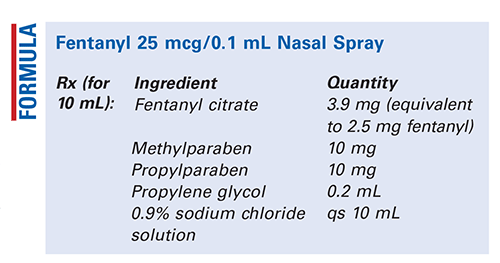US Pharm. 2021;46(4):60-CV3.

Method of Preparation: Calculate the required quantity of each ingredient for the total amount to be prepared. Accurately weigh or measure each ingredient. Dissolve the methylparaben and propylparaben in the propylene glycol. Dissolve the fentanyl citrate in about 9 mL of 0.9% sodium chloride solution. Add the parabens previously dissolved in the propylene glycol and mix well. Add sufficient 0.9% sodium chloride solution to volume and mix well. Package in a metered spray bottle and label.
Use: Fentanyl is used in the treatment of moderate-to-severe pain. The nasal spray topical dosage form may be used to adjust the dosage for a specific patient.
Packaging: Package in tight, light-resistant metered nasal spray bottles.
Labeling: Keep out of reach of children. Discard after ____ [time period]. For nasal use only.
Stability: A beyond-use date of up to 30 days may be used for this preparation.1
Quality Control: Quality-control assessment can include weight/volume, pH, specific gravity, active drug assay, color, clarity, rheologic properties/pourability, physical observation, and physical stability (discoloration, foreign materials, gas formation, mold growth).2,3
Discussion: Fentanyl citrate is a synthetic opioid used as a sedative, analgesic, preoperative medication, and adjunct to general or regional anesthesia; it is also used in the management of chronic pain. Fentanyl citrate (C22H28N2O.C6H8O7, MW 528.6) occurs as white granules or as a white, crystalline powder. Fentanyl citrate 157 mcg is approximately equivalent to 100 mcg of fentanyl. It is soluble 1 g in 40 mL of water and slightly soluble in alcohol. The pH of the fentanyl injection is in the range of 4.0 to 7.5.4
Methylparaben (methyl hydroxybenzoate, methyl parahydroxybenzoate, C8H8O3) is available as colorless crystals or as a white, crystalline powder that is odorless or almost odorless and has a slight burning taste. It is an antimicrobial preservative and is most effective in solutions with a pH between 4 and 8. Methylparaben has a melting point of 125°C to 128°C and a pKa of 8.4. It is soluble 1 g in 400 mL of water, 3 mL of 95% ethanol, 60 mL of glycerin, 200 mL of peanut oil, and 5 mL of propylene glycol.5
Propylparaben (propyl hydroxybenzoate, propyl parahydroxybenzoate, C10H12O3) is available as a white, crystalline, odorless, tasteless powder. It is an antimicrobial preservative and is most effective in solutions with a pH between 4 and 8. Propylparaben has a melting point of 95°C to 98°C and a pKa of 8.4. It is soluble 1 g in 2,500 mL of water, 1.1 mL of ethanol, 250 mL of glycerin, 3,330 mL of mineral oil, 70 mL of peanut oil, and 3.9 mL of propylene glycol.6
Propylene glycol (C3H8O2) occurs as a clear, colorless, viscous, practically odorless liquid with a sweet taste, somewhat resembling glycerin. It has a specific gravity of 1.038 g/mL and is miscible with acetone, chloroform, 95% ethanol, glycerin, and water. Propylene glycol is similar to ethanol as an antiseptic; it is stable and may be mixed with numerous other solvents.7
0.9% sodium chloride injection contains not less than 95.0% and not more than 105.0% of the labeled amount of sodium chloride in Water for Injection. This ingredient has a pH of 4.5 to 7.0, and it contains no added antimicrobial agents.8
REFERENCES
1. U.S. Pharmacopeia/National Formulary [current revision]. Rockville, MD: U.S. Pharmacopeial Convention, Inc; March 2021.
2. Allen LV Jr. Summary of quality-control testing for sterile and nonsterile compounded preparations, part 1: physical and chemical testing. IJPC. 2019;23(3):211-216.
3. Allen LV Jr. Summary of quality-control testing for sterile and nonsterile compounded preparations, part 2: microbiological testing. IJPC. 2019;23(4):299-303.
4. Reynolds JEF, ed. Martindale: The Extra Pharmacopoeia. 38th ed. London, England: Pharmaceutical Press; 2014:A60-1-A64-2.
5. Maheswaran R, Nair R. Methylparaben. In: Sheskey PJ, Hancock BC, Moss GP, Goldfarb DJ, eds. Handbook of Pharmaceutical Excipients. 9th ed. London, England: Pharmaceutical Press; 2021:670-674.
6. Quinn ME. Propylparaben. In: Sheskey PJ, Hancock BC, Moss GP, Goldfarb DJ, eds. Handbook of Pharmaceutical Excipients. 9th ed. London, England: Pharmaceutical Press; 2021:878-881.
7. Quinn ME. Propylene glycol. In: Sheskey PJ, Hancock BC, Moss GP, Goldfarb DJ, eds. Handbook of Pharmaceutical Excipients. 9th ed. London, England: Pharmaceutical Press; 2021:867-870.
8. Watters M. Sodium chloride. In: Sheskey PJ, Hancock BC, Moss GP, Goldfarb DJ, eds. Handbook of Pharmaceutical Excipients. 9th ed. London, England: Pharmaceutical Press; 2021:945-949.
The content contained in this article is for informational purposes only. The content is not intended to be a substitute for professional advice. Reliance on any information provided in this article is solely at your own risk.
To comment on this article, contact rdavidson@uspharmacist.com.





